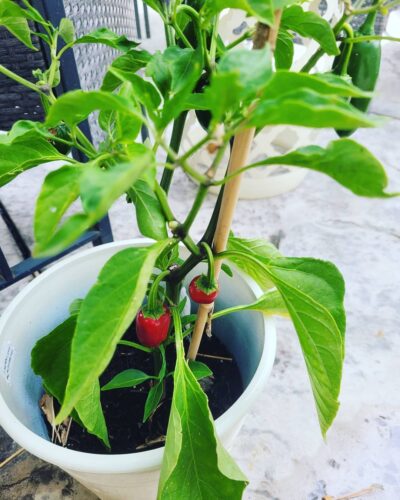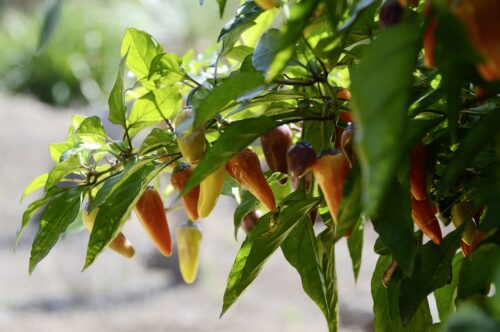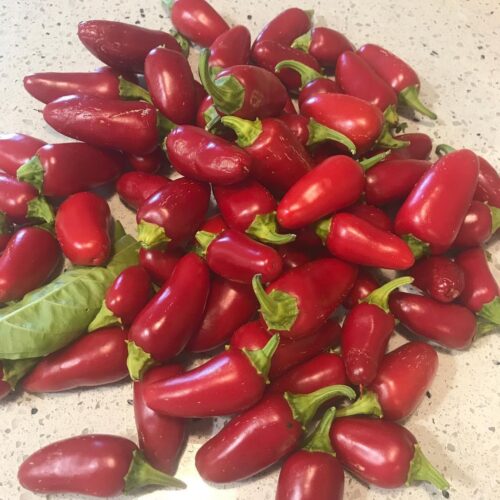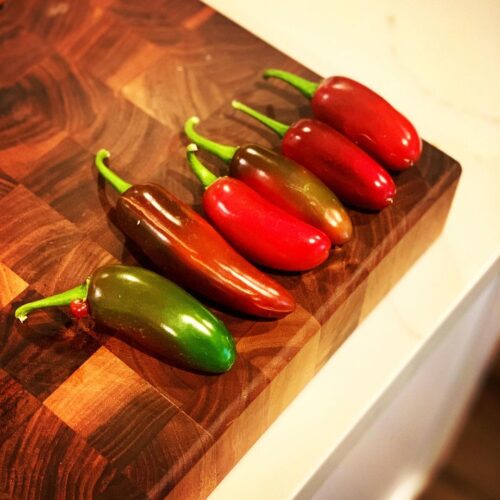Learn How to Grow Red Jalapeños easily with this detailed guide. Get expert tips for a successful pepper garden.
Discover How to Grow Red Jalapeños in your garden. This beginner-friendly guide will walk you through the process, ensuring you can enjoy these spicy delights from home.
READ Ghost Pepper vs. Carolina Reaper: Differences
What is Red Jalapeños

Red jalapeños (Capsicum annuum) belongs to the Solanaceae family. They are native to Mexico, specifically in the region of Veracruz.
They are small, elongated peppers that typically measure 2-3 inches in length. These peppers are bright red when mature and have a slightly wrinkled appearance.
In terms of growth, Red Jalapeños plants have a moderate growth rate. They can reach a height of about 2-3 feet and have a similar spread, making them suitable for smaller gardens or containers.
The flowers of the Red Jalapeños plant are small and white with five petals. They are typically self-pollinating, meaning they can produce fruit without the need for external pollinators like bees or insects.
The foliage of Red Jalapeños plants consists of green leaves that are generally oval or lance-shaped. These leaves provide shade and support for the developing peppers.
Red Jalapeños are known for their spicy flavor, with a Scoville Heat Unit (SHU) rating ranging from 2,500 to 8,000 SHU, making them moderately hot. They are commonly used in various cuisines to add a spicy kick to dishes like salsas, sauces, and pickles. When harvesting, it’s essential to handle them carefully, as the oils from the peppers can irritate the skin and eyes, so wearing gloves is recommended. Red Jalapeños are also a good source of vitamins and antioxidants.
READ Carolina Reaper Growing Tips
How to Propagate Red Jalapeños

Methods to propagate Red jalapeños:
- Seed Propagation
- Cuttings
- Transplanting
Seed propagation is one of the easiest methods to propagate red jalapeños. Here’s how to do it:
- Seed Selection: Begin by selecting mature red jalapeños. Choose peppers from healthy plants that have produced desirable fruits.
- Extraction: Cut open the red jalapeños and remove the seeds from inside. Be sure to wear gloves or wash your hands thoroughly afterward, as the seeds can contain capsaicin, which can cause skin and eye irritation.
- You can also purchase seeds from online sources or nurseries.
- Seed Drying: Spread the seeds on a paper towel or a tray and allow them to air dry for several days. Make sure they are completely dry before proceeding.
- Planting: Fill small seedling pots or trays with potting soil. Plant the dried jalapeño seeds about 1/4 inch deep in the soil. You can plant multiple seeds in each pot to increase the chances of germination.
- Germination: Keep the soil consistently moist and place the pots in a warm, sunny location or under grow lights. Red jalapeños seeds typically germinate within 2 to 3 weeks.
- Transplanting: Once the seedlings have developed several true leaves and are sturdy enough, transplant them into larger pots or your garden, spacing them at least 18 inches apart.
- Care: Continue to water and provide adequate sunlight as the plants grow. Red jalapeño plants are sensitive to frost, so make sure to transplant them outdoors after the last frost date in your area.
Pot Size for Growing Red Jalapeños
For Red jalapeños, a 5-gallon (19-liter) pot made of durable plastic or terracotta is ideal. Ensure the pot has drainage holes to prevent waterlogging. Good drainage is crucial for healthy pepper plants. A pot of this size provides ample space for root growth and stability while allowing proper moisture control.
Find Black Pepper Plant Growing Zone Tips
Ideal Growing Conditions for Red Jalapeños

Light / Location
Red jalapeños thrive in full sunlight, which means they need at least 6-8 hours of direct sunlight daily. Place them where they receive the most sun, typically facing south or southwest, for optimal sun exposure. Ensure they get enough light for healthy growth, fruit production, and robust flavor.
Soil
Red jalapeños prefer well-draining, loamy soil with a pH level between 6.0 to 6.5. To improve soil, mix in organic matter like compost or aged manure at a ratio of 1:3 (organic matter to soil). This enhances nutrient retention, promotes healthy root development, and aids in robust plant growth.
Water
Red Jalapeño plants require consistent watering to thrive. Water them deeply once a week, allowing the soil to dry slightly between watering. Use a soaker hose or drip irrigation to deliver water directly to the root zone, avoiding wetting the leaves. Adjust the frequency based on local weather conditions.
Temperature and Humidity
Red Jalapeños plants prefer temperatures between 70°F and 90°F (21°C to 32°C) during the day and no lower than 50°F (10°C) at night. They thrive in moderate humidity levels of 40-60%. Protect them from frost, as they are sensitive to cold temperatures.
EXPLORE Best Tips to Make Pepper Plants Hotter
Red Jalapeños Care
Fertilizer
Red Jalapeños benefit from balanced fertilizers with an NPK ratio of around 10-10-10 or 5-10-10. Apply fertilizer when planting and then every 4-6 weeks during the growing season, but avoid fertilizing during dormancy. Organic options like compost or well-rotted manure can also nourish the plant effectively.
TIP: To enhance your plant’s growth, use Epsom salt by mixing 2 teaspoons with 2 liters of water and applying it monthly during watering. Boost calcium levels by scattering crushed eggshells around the base and occasionally blending them into the soil for improved fruit production. When transplanting, consider adding a handful of bone meal to the planting hole for extra nutrients.
Pruning
Red Jalapeño plants benefit from pruning to encourage bushier growth and higher yields. Use clean, sharp shears to remove the top few inches of the main stem when the plant is 8-10 inches tall. Pinch off any small shoots or leaves that compete with the main stem. Prune in early spring.
Pollination
Red Jalapeños are typically self-pollinating, but they can benefit from pollinators like bees and wind to ensure thorough pollination. Gently shaking the plant or using a small brush to transfer pollen between flowers can also aid in fruit production.
Overwintering
To successfully overwinter your red jalapeño plant, transfer it to a container before the first frost. Place it near a sunny, south-facing window indoors, ensuring protection from drafts and dry heating vents. Water when the top inch of soil becomes dry, and trim back leggy stems caused by insufficient light.
Pests and Diseases
Pests:
- Aphids: These small insects feed on plant sap and can weaken the plant. Use insecticidal soap or neem oil to control them.
- Spider Mites: They can cause stippling on leaves. Spray the plant with water or use neem oil to deter them.
- Whiteflies: These tiny insects can transmit viruses. Yellow sticky traps or insecticidal soap can help manage them.
Diseases:
- Bacterial Leaf Spot: Causes dark lesions on leaves. Avoid overhead watering and use copper-based fungicides.
- Powdery Mildew: A white powdery growth on leaves. Improve air circulation and use fungicides when needed.
- Phytophthora Root Rot: Can cause wilting and root damage. Ensure well-draining soil and avoid overwatering.
- Tobacco Mosaic Virus: Causes mosaic patterns on leaves. Remove infected plants to prevent spread.
Discover Fennel vs. Celery: Differences
Harvesting

To harvest Red Jalapeños, wait until they turn fully red, which indicates ripeness. Wear gloves to protect your hands from the spicy oils. Use pruning shears or scissors to snip the peppers from the plant, leaving a short stem attached. Harvest regularly to encourage more fruit production and enjoy them in your recipes.
CHECK out Xoconostle Fruit Growing and Benefit Information
Red Jalapeños vs. Green Jalapeños

Ripeness:
The most significant difference between Red and Green Jalapeño Peppers is their level of ripeness. Red Jalapeños are matured Green Jalapeños. As they ripen, they change from green to red, which is why they have a different color.
Flavor:
Red Jalapeños tend to have a slightly sweeter and fruitier flavor compared to Green Jalapeños. The ripening process allows them to develop more complex and nuanced flavors.
Heat Level:
Generally, Red Jalapeños are milder in terms of spiciness compared to their green counterparts. This is because the capsaicin, responsible for the heat in peppers, decreases as the pepper matures and turns red.
Texture:
The texture of Red Jalapeños can be slightly different. They are often described as being a bit softer or more pliable than the firmer green ones, although this may vary based on their freshness.
Uses:
Both Red and Green Jalapeños can be used in a variety of culinary applications. Green Jalapeños are often preferred for their sharper and more intense heat, while Red Jalapeños are favored for their sweeter, more subdued spiciness. Red Jalapeños are commonly used in salsas, hot sauces, and dishes where their color and milder heat complement the flavors.
Appearance:
As the name suggests, Green Jalapeños are green in color. Red Jalapeños are, of course, red, and they can be somewhat wrinkled or have slightly different shapes due to their maturity.
READ Choy Sum (YU Choy) Growing Tips
Cooking with Red Jalapeños

- Cooking with Red Jalapeño Peppers adds a spicy kick and flavor to dishes.
- To use them, first remove the seeds and membranes for milder heat.
- You can chop or slice them to add to salsas, sauces, and marinades.
- For extra spice, leave the seeds intact. Be cautious when handling them, as their oils can irritate the skin and eyes.
- Adjust the quantity based on your spice preference, and enjoy the fiery flavor they bring to your recipes.
Read Celery Root vs. Jicama: Differences
FAQs
Q: How do I encourage bushier growth in Red Jalapeño plants?
A: Prune the plant by removing the top few inches of the main stem when it reaches 8-10 inches in height. Pinch off small shoots or leaves that compete with the main stem.
Q: Can I grow Red Jalapeño peppers in containers or pots?
A: Yes, Red Jalapeños can be grown in containers or pots. Choose a large enough container with good drainage and follow proper care and watering guidelines.
Q: What should I do if my Red Jalapeño plants become too tall and leggy?
A: If your plants become leggy due to insufficient light, consider providing supplemental light or trimming back the stems to encourage bushier growth.
Q: Are there any specific companion plants that go well with Red Jalapeño peppers?
A: Red Jalapeño peppers can benefit from companions like basil, oregano, and marjoram, which can help deter certain pests and enhance their growth.
Q: Are Red Jalapeños suitable for pickling or preserving?
A: Yes, Red Jalapeño peppers can be pickled or preserved to extend their shelf life and add a zesty flavor to various dishes.



